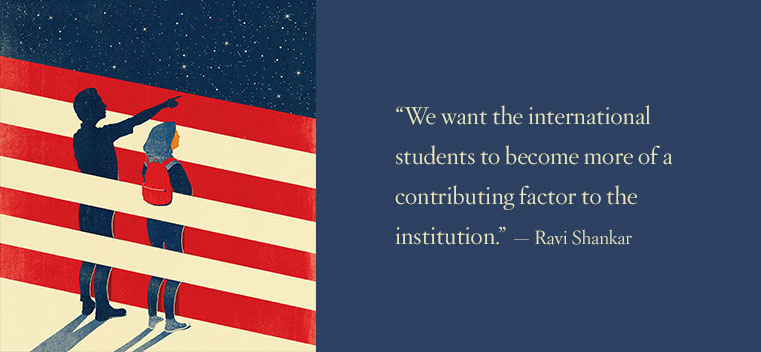
A Home Away from Home
Tell us what you think. E-mail comments or questions to the editors at letters@northwestern.edu.
Find Us on Social Media
Northwestern’s International Office helps students from overseas find their fit in the fabric of the University.
Moein Hosseini had been in the United States for just a few months when President Donald Trump signed an executive order banning citizens from seven majority Muslim countries from entering the United States, including Hosseini’s homeland, Iran.
When Trump signed a revised order in March, the University quickly organized a Guild Lounge dinner for those affected by the ban. Dan Linzer, then the provost, and Student Affairs vice president Patricia Telles-Irvin and International Office director Ravi Shankar were among the Northwestern officials on-hand to discuss the executive order, hear international students’ concerns and explore how Northwestern might provide support, including legal advice. Hosseini knew immediately that the University backed him.
“It was very nice to have this conversation and to know about these supports from high-level people in the University,” says Hosseini, a second-year civil engineering doctoral student from Tehran who is studying transportation systems analysis and planning.
The University’s International Office played a key role in that April meeting and advocates for Northwestern’s international population year-round, providing valuable guidance on a host of issues, from visa and immigration to how to prepare for winter.
The office serves the University’s ever-expanding international population, which now includes 5,000 undergrad and graduate students — a number that swells to 7,000 when you include international scholars, faculty and their families. President Morton Schapiro has pushed to make the University more global. Fifteen years ago there were 1,700 international students, including just 100 undergraduates.
International students and scholars bring new perspectives and knowledge, as well as economic contributions to the local and national economies, says Shankar. Through tuition and living expenses, international students contribute an estimated $35.8 billion to the U.S. economy, making it the fifth-largest service export sector. International education adds $1.6 billion to the Illinois economy and $196 million locally.
The office helps to support students through their cultural and academic transition and attempts to “get students engaged beyond their lab, beyond the classroom,” says Shankar.
The IO’s work on behalf of international students starts before they even arrive on campus. Each summer, the office sends staff members to seven cities in China, India and Korea for NU In, an in-country, predeparture orientation program that typically draws 600-plus undergrad and graduate students. Once on campus, the International Office hosts on-campus orientations, led by volunteer peer advisers, for undergrad and graduate students and parents.
The office also partners with Counseling and Psychological Services to offer weekly Discovering USA sessions for graduate students, addressing a breadth of issues, including culture shock, identity and social justice.
“These activities help international students get more involved and feel more included within the community,” says Yu Yin ’17 MS, a member of Northwestern’s Chinese Student and Scholar Association.
The office also organizes an annual spring break service trip to Memphis, where 10 graduate student volunteers work with Serve 901, focusing on social justice and policy issues. Puja Bhattacharjee ’17 MS, who came to Northwestern from Kolkata, India, for a master’s in journalism, attended the trip last March. Her group volunteered at an after-school refugee program and helped out on an urban farm, planting sweet potatoes in stacks of old tires and laying pipes for a catfish pond. The group also visited the National Civil Rights Museum and Slave Haven Underground Railroad Museum.
“I’ve always been interested in volunteer work, and a strong part of that trip focused on social justice issues,” says Bhattacharjee. “That was a big draw.”
The IO also offers weekly coffee hours as part of its programming for spouses and families, and it supports the Community Council for International Students, which runs programs for dependents that include an English conversation partner program and a children’s playgroup.
Every Thanksgiving, IO connects international students with hosts from throughout Evanston and Chicago, who welcome them for a traditional feast. Last year more than 100 faculty, staff, alumni and community members opened their homes to 275 students and scholars. “The international students not only learn about the culture but also get a glimpse into a typical U.S. family,” says Shankar.
“We want the international students to become more of a contributing factor to the institution,” he adds. “We are very consciously trying to figure out the best methods to engage international students into the fabric of the University community.”



 Facebook
Facebook Twitter
Twitter Email
Email


